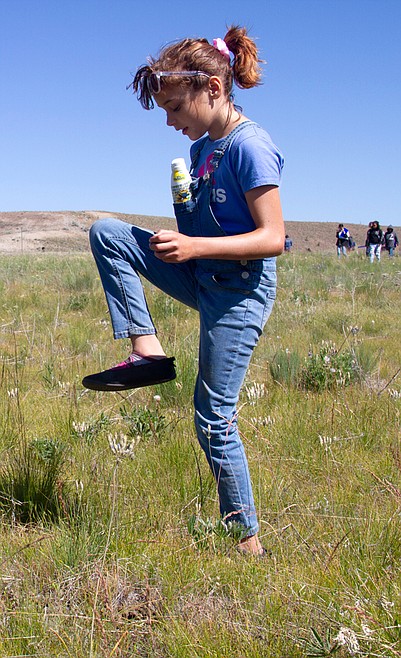Tribal youth aid pollinators with Extension-improved seed bombs
| September 25, 2023 1:00 AM
NESPELEM — Two summers ago, prairies burned as towns on the Confederated Tribes of the Colville Reservation filled with smoke from the 54-square-mile Chuweah Creek Fire.
This year, the scene couldn’t have been more different as youth from across the reservation joined Washington State University Extension educators to revitalize the environment, help pollinators, and serve their community by dispersing seed bombs—clay balls filled with native plant seeds.
“The fire hit home for these kids and their families,” said Linda McLean, director and 4-H Positive Youth Development Program coordinator with WSU Colville Reservation Extension. “Today they’re learning ways to give back and help heal the earth.”
Connecting lessons to life
With firm stomps, hundreds of children broke clay spheres under their sneakers, releasing seeds of biscuitroot, yarrow, flax, and other native wildflowers into dusty soil that still bears signs of fire.
More than 300 students and Head Start preschoolers from Nespelem, Inchelium, Lake Roosevelt, and Keller schools made and dispersed more than 2,000 seed balls during field days in June, visiting tribal range land near Nespelem that burned during the Chuweah Creek fire.
“This trip connects their learning to the real world,” said Dolly Brudevold, a K-1 and special education teacher at Keller Elementary School.
Throughout the year, her class discusses the environment and the seasons and how they affect their community, state, and the wider world. Meeting 4-H educators and going outdoors to spread seed balls is a culmination that helps make lessons more memorable.
Teachers, 4-H educators, and staff with USDA-NIFA’s Federally Recognized Tribes Extension Program joined personnel with the Colville Tribes Fish and Wildlife Department and Range Department, the Mount Tolman Fire Center, Environmental Trust program, Youth Development and the Colville Reservation Boys and Girls Club to share lessons on fire safety, wildlife, and native plants and insects.
“These students are keen to nature’s wrath because they lived it,” Brudevold said. “The burn changed the landscape,” damaging important plants and the threatened insect pollinators they depend on. “One of our goals is to bring them back so they can do nature’s work.”
“I love butterflies,” said one Nespelem middle schooler. She remembered that the fire burned trees and other plants around her community. “I find it really tragic. That’s why we wanted to come out here and plant them.”
Building a better seed ball
The Nespelem site was the scene of WSU Extension’s first seed bomb field day last June.
“This trip was meant for them to see what had grown from last year,” McLean said.
Few of last summer’s bombs sprouted. The clay balls were too thick and failed to break down, instead baking in a hot summer.
Working with tribal partners and WSU Extension Master Gardeners, McLean put together a new method and set of instructions for children to make thinner balls with more surface seeds, then step them into the ground for better soil contact.
“With the adjustment, we’re hoping to see more plant growth,” Brudevold said.
Along with creating the seed bombs and educating about pollinators, McLean and colleague Jonnie Bray, Colville Reservation FRTEP Agriculture and Natural Resources Coordinator, shared the mission of 4-H, which is offered statewide through WSU Extension.
“4-H is about life skills and community service,” McLean said. “We’re asking youth for their help. They’re contributing through citizen science to protect pollinators and help the earth heal.”


